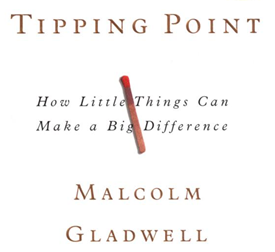 Gladwell’s The Tipping Point is a cerebral journey into the psychology of mass movements. As he puts it, the book “is the biography of an idea . . . ideas and products and messages and behaviors spread just like viruses do” (7). He attempts to discern how trends become fashionable, how unexpected societal changes come to be. It’s a well-researched and audacious explanation of something that for most people is unexplainable: how do movements (fashion, cultural, societal) happen?
Gladwell’s The Tipping Point is a cerebral journey into the psychology of mass movements. As he puts it, the book “is the biography of an idea . . . ideas and products and messages and behaviors spread just like viruses do” (7). He attempts to discern how trends become fashionable, how unexpected societal changes come to be. It’s a well-researched and audacious explanation of something that for most people is unexplainable: how do movements (fashion, cultural, societal) happen?
His three agents of change that he identifies are these:
The Law of the Few – in any epidemic, there are a few specialized people that provide the catalyst for a movement taking off. “Connectors” know everyone, and can connect a burgeoning movement or trend with an almost infinite amount of people. “Mavens” know everything about everything and provide the knowledge that fuels a movement. “Salesman” are people who can persuade anyone to join anything. These few types of people drive a trend or movement.
The Stickiness Factor – Using case studies such as Sesame Street and Blue’s Clues, Gladwell looked at how successful programs tweaked their approach through extensive research and feedback to get a product that “stuck” with the audience. Little tweaks can go a long way.
The Power of Context – this makes the argument that human beings are a lot more sensitive to their environment than they may seem. For instance, cleaning graffiti off of subways and punishing fare beaters (a small crime) helped turn the tide in the crime epidemic of New York City. People respond to their environment. If you change the environment, you can change the people.
He adds a second caveat to the Power of Context: the rule of 150. Looking at the size of our neocortex, he stipulates that the optimum size of our social groupings is 150. Any larger than that, and the effectiveness of the group or organization quickly dissipates.
Gladwell does an incredible job looking at case studies and trying to delve into the causes to their success. Why did one fashion trend take off so suddenly? Why did crime disappear in New York City? Why did Sesame Street and Blue’s Clues succeed where so many other children’s shows did not?
The greatest strength of the book is his research and exploration of real-life situations. Rather than simply quoting statistics or rehashing someone else’s research, Gladwell takes us with him as he explores real-life situations with incredible depth. This also becomes his most glaring weakness, however. Because of the in-depth nature of his examples, he only shares a few. Trying to pull universal truths out of individual cases can leave some readers unconvinced. More examples of the same truth would have created a more compelling case.
LESSONS LEARNED
1. The Law of the Few mirrors biblical truth. In Matthew 25:14-30, Jesus shares a parable of three servants given three differing amounts of money to be invested while their master is gone. Two servants invest, one does not. The master returns and rewards those who invested his money, and condemns the one who doesn’t. What’s inconsequential in this parable is that the servants were given differing amounts of money (one talent, five talents, ten talents of gold).
Now, as with all parables, several truths can be pulled out of them. Here’s what’s always struck me about this parable: different humans are given differing skills, or “talents.” What’s important is not how much we’re given in life, but what we do with what we have been given. Jesus has no sympathy for the servant who complains about his lot in life.
When Gladwell speaks of Mavens, Connectors, and Salesmen, I think he’s referring to “ten talent people,” people born with a higher capacity to lead and influence. Some may cry “not fair,” but I think that’s simply the reality of life.
2. Leadership matters. Once again playing off of the Law of the Few, it is a select group of people that can cause the success of an organization or movement. As business guru Jim Collins teaches, getting the right people on the bus and getting the right people on the right seats on the bus can make all the difference in the world.
3. Excellence takes work. I loved his delving into the intricacies of Sesame Street and Blue’s Clues, especially the description of the lengths the creators went to make a sticky product. Too many people today want easy and instant success. After the first hint of success, too many people are content to rest of their laurels. (I always think about the aging rock bands who are content to play the one successful song they made thirty years ago).
True stickiness takes a lot of tweaking and hard work. It doesn’t have to be wholesale changes, but small changes made after research and feedback. The difference of stickiness many times comes down to someone’s relentless pursuit of perfection in whatever field they’re in. As a preacher, do I have the discipline and tenacity to constantly tweak my communication style until it’s sticky?
4. Your environment affects your people. The Power of Context was especially powerful for me. There’s always a tug-of-war in churches about spending money to improve the facilities. If a building looks outdated, some may want to upgrade, and some may counter that it’s a frivolous waste of tithe money, money that could have gone to more worthwhile causes.
According to Gladwell, environmental improvements are more than exercises in vanity. Environments affect how people respond to and interact with others. Disneyworld figured this out a long time ago. Churches are a little slower on the uptake.
A person’s worship experience starts in the parking lot. By the time he or she sits down to listen to a message, that person has already been incredibly influenced to worship in a certain way, because of the environment. Gladwell exposes a fundamental truth about how humans were created. If churches understood the importance of context, then we’d do everything we could to make sure the environment was as excellent as possible.
QUESTION: Have you ever met a Connector, Maven, or Salesman?











